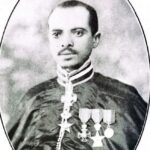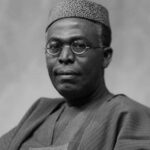LONGANGI
- 8 Min Read
Longangi (circa 1860-July 14, 1964) was a forceful and ambitious individual elevated by the colonial government to serve as chief over the politically decentralised Lega people of eastern Kivu. As an agent of the colonial administration, Longangi worked to promote the interests of Europeans in government, companies, and missions. Frequently, this cooperation brought Longangi into conflict with individuals and institutions in Lega traditional society.
Longangi was born in Lega lands about 80 km (50 mi) southwest of Lake Kivu, an area influenced by Swahili traders who had come into nearby regions from East Africa by 1869. Although little is known about his mother Kuntebe, his father Mpaga Munyantangoy was one of the first Nyampara (assistants) of the Swahili merchant sultans seeking to conquer and control the territory. In his search for slaves and ivory, Mpaga Munyantangoy led African soldiers against Kivu villages. When Mpaga was killed by his men during one of these raids, his employer Musekula, or Musareka, adopted the young Longangi as his son.
Longangi’s adoption into the family of the Swahili adventurer marked the beginning of a long career in trade and politics. Through his contact with the Swahili, Longangi learned to handle a rifle, he also mastered the Swahili language, the future regional ‘lingua franca.’ At a time when few local Africans could speak Swahili, Longangi became an indispensable intermediary between the East African merchants and the local peoples.
When the Congo Free State established control over the area after 1900, colonial agents were eager to hire men like Longangi as interpreters. From interpreter-police auxiliary, Longangi advanced to a position as the European-appointed chief over the local African population. Since the traditional leaders fled the whites out of fear, by default they allowed Longangi to act as their intermediary with the Europeans.
Despite his humble origins, and despite grumblings from other Lega, Longangi gained increasing political control. In 1924 he was named head of a newly created Basile chiefdom encompassing several Lega clans in the present Mwenga Zone in Kivu (Mwenga is about 70 km or 40 mi southwest of Bukavu). In 1928, Longangi consolidated his power by ousting Kalenga
Kitoga, a legitimate descendant of Sile, was the ruler of Basile (people tracing descent from Sile). Longangi also took over the Wamuzimu chiefdom, although his position as head of the Wamuzimu clans was never accepted as legitimate by the people themselves. Invested in 1931, as chief of the great Wamuzimu chiefdom established by the colonial administration, Longangi strengthened his authority by installing his men as village notables or headmen.
In villages where the incumbent leaders were hostile, he simply relieved them of their duties and, sometimes, had them banished. Thus, Kalenga Kitoga, the original chief of the Basile, was banished to Rutshuru, 60 km (35 mi) northeast of Goma, in 1922. His son and successor, Kalenga Kyalumba, was then invested as a notable of the Wamuzimu chiefdom, but the antagonism between the two families continued until 1960, when the chiefdom was divided. The southern part, headed by Longangi, kept the name Wamuzimu, while the north, which took the former name Basile, was given to Kalenga Kitonga’s grandson, Kalenga Lwango.
For many years Longangi acted as the only representative of the Lega populations of the Wamuzimu chiefdom in dealing with the European administrators, company agents, missionaries, and colonists. All the territorial agents’ inspection reports on the Wamuzimu chiefdom contained praise for Longangi. In 1952, the district commissioner of Kivu wrote that Longangi was “the best chief of the Mwenga territory… a man who had done great services during his long career.” In 1957, another official described Longangi as “very loyal and devoted to the European cause.”
Covering more than 6,225 square kilometers, with a total population of 46,081 in 1953, Longangi’s chiefdom was large and wealthy. The southern branch of the Compagnie Minière des Grands Lacs (Great Lakes Mining Company, or M.G.L.), which had mined gold in Wamuzimu since 1932, annually employed about ten thousand men, many from Longangi’s territory. Furthermore, the chiefdom was the supply center both for the workers’ camps and the city of Bukavu on Lake Kivu, which required large quantities of rice, palm oil, peanuts (ground nuts), bananas, and manioc (cassava).
During the colonial period, Longangi’s power increased. Accompanied by an imposing train of guards and porters, he annually crossed his vast chiefdom in a litter. In later years he traveled by auto-mobile. Longangi held palavers, requisitioned supplies, and porters, recruited labourers, raised contingents of militiamen, relocated farmers to the areas around the mining camps, and acted vigorously to help the colonists maintain order on the plantations and missions.
A powerful man, Longangi could rely on support from the colonial administration and police. A wealthy man, Longangi was the only African in the territory who owned a vehicle. He was easily able to make up, from his own funds, a deficit of 60,000 francs in the chiefdom’s treasury. His wealth was measured in more than money, for in the tradition of a great Swahili ruler, he had an imposing court with a harem which included more than 30 wives, who bore him more than 100 children.
Despite Longangi’s great influence, primary power in the Lega lands and in the Wamuzimu chiefdom remained in the hands of the semi-secret Bwami society. Traditionally, social, economic, religious, and moral authority among the politically decentralised Lega was exercised by the Bwami. Lega individuals achieved membership in the Bwami only after a rigorous training period which culminated in an elaborate initiation ceremony. From the Lega perspective, this practice guaranteed that those in authority were persons of exceptional intellectual and moral aptitude. The Bwami, therefore resented Longangi, whom they regarded as a colonial auxiliary who held power by force and coercion rather than by merit and cultural achievement.
Although from the 1920s, the Belgian administration outlawed the Bwami association, neither Longangi, nor any other European appointed chiefs; could ignore or diminish Bwami influence. The Bwami caused difficulties for Longangi. Some Bwami-linked families notably that of Kalenga, challenged his rule. In seeking to diminish Bwami influence, Longangi co-operated with the missionaries in opposing traditional religion, punishing Bwami dignitaries, forbidding initiation into the Bwami, and returning runaway students to mission schools seeking to re-educate the Lega.
Besides the Bwami, Longangi confronted other religious sects, such as the Mulonge, Punga, and Kinzenze, which appeared just after World War II. Adherents of these sects ignored government authority, escaped from prisons, broke work contracts, resisted taxes, and refused to work as porters. By severely punishing the leaders and followers of these various sects, Longangi and the Belgians made it difficult for them to gain a foothold in Lega lands. Another reason for their obvious lack of success in the region was the stabilising presence of the Bwami society. Thus, novel religious movements had little appeal for the Lega.
Old age finally weakened the powerful chief Longangi. If, in the 1950s Longangi still reigned over the Wamuzimu chiefdom, he no longer governed it. In 1952, the colonial administrators began searching seriously for a successor. Although Longangi’s son Diemba, a former driver for the Société de Transport de l’Administration (Administration Transport Company, or S.T.A.), became his assistant, Diemba had neither the stature nor the authority of his father. Thus, on April 10, 1960, the colonial government decided to divide the Wamuzimu chiefdom into two smaller units, a Basile chiefdom and a more restricted Wamuzimu chiefdom. Powerless, Longangi witnessed first the disintegration of his empire and then, after June 30, 1960, the sudden and forced departure of his former supporters, the Belgians. Turning over the real exercise of power to his son, Longangi withdrew to his court where he lived with his old servants.
In 1964 separate anti-government rebellions broke out in Kasai’s Kwilu province and in the eastern regions of the Congo. The Kwilu uprising was led by Pierre Mulele while the eastern insurrection was initiated by the Conseil National de Liberation (National Liberation Council), a group composed of former followers of Patrice Lumumba. Although the two movements were not linked by a common organisation or command, the eastern rebels had tremendous respect for Mulele who, they believed, dispensed magical powers making warriors invincible.
On the morning of June 22, 1964, partisans began an attack on Longangi’s court, Kitutu, 120 km (70 mi) southwest of Bukavu. Although Longangi organised the defense of Kitutu, the advancing rebels, who shouted “Mayi Mulele” (“Mulele water,” a special water thought to give them magical powers), could not be halted. Thus, Longangi, with all his family, fled to Bukavu. This hasty flight, along with the remorse Longangi must have felt from abandoning his endangered troops, led to the 100-year-old chief’s death in a Bukavu hospital on July 14, 1964.
Drawing a lesson for the troubled times after 1960, Longangi advised union and cooperation. “To be strong my sons,” he said, “gather yourselves around a single authority. With too many chiefs, you will fight among yourselves and be weak.” Longangi’s counsel reflected his life’s work of attempting to bring previously decentralised peoples under a single, Western-supported government structure.
YOGOLELO TAMBWE ya KASIMBA




